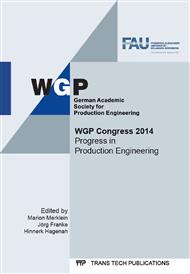p.175
p.183
p.189
p.199
p.207
p.215
p.223
p.229
p.237
Adjusting of Roller Levellers by Finite Element Simulations Including a Closed-Loop Control
Abstract:
Within today’s sheet processing lines, roller levellers are included in the production chain to eliminate initial curvature and reduce internal stresses of the sheet material. Despite the desire to achieve fully automated industrial processes, roller levellers still have to be set manually by an operator based on his experience and empirical data. Therefore, this paper evaluates an enhanced numerical approach to predict the vertical roll position, the so called roll intermesh, in the last load triangle. To gain the respective machine setting, a closed-loop control based on an actual curvature measurement is implemented in the finite element (FE) programme Abaqus utilising a user-subroutine. Thus, the presented FE model allows the adjustment of the roller leveller leading to a flat strip in a single simulation run within the accuracy of the FE prediction. Additionally, the FE model provides the chance to develop and test closed-loop controls for roller levelling. Complementing the results gained from the FE model, experiments have been conducted on a down-sized roller leveller with aluminium sheets (AA5005). First results obtained with the presented numerical model proved that the roll intermesh of the last load triangle was determined successfully and the use of an actual curvature measurement within the FE model provides enhanced accuracy.
Info:
Periodical:
Pages:
207-214
Citation:
Online since:
September 2014
Authors:
Keywords:
Price:
Сopyright:
© 2014 Trans Tech Publications Ltd. All Rights Reserved
Share:
Citation:


